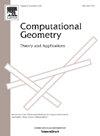平面中避开某线段的凸集穿孔族
IF 0.7
4区 计算机科学
Q4 MATHEMATICS
Computational Geometry-Theory and Applications
Pub Date : 2024-02-27
DOI:10.1016/j.comgeo.2024.102087
引用次数: 0
摘要
我们将 a 定义为这样的集合族,即当(指数取模)时,a 。我们证明,如果是一个不包含 a 的紧凑凸集族,那么就有直线穿透 。此外,我们还给出了一个紧凑凸集合族的例子,它不包含且不能被直线穿透。本文章由计算机程序翻译,如有差异,请以英文原文为准。
Piercing families of convex sets in the plane that avoid a certain subfamily with lines
We define a to be a family of k sets such that when (indices are taken modulo k). We show that if is a family of compact, convex sets that does not contain a , then there are lines that pierce . Additionally, we give an example of a family of compact, convex sets that contains no and cannot be pierced by lines.
求助全文
通过发布文献求助,成功后即可免费获取论文全文。
去求助
来源期刊
CiteScore
1.60
自引率
16.70%
发文量
43
审稿时长
>12 weeks
期刊介绍:
Computational Geometry is a forum for research in theoretical and applied aspects of computational geometry. The journal publishes fundamental research in all areas of the subject, as well as disseminating information on the applications, techniques, and use of computational geometry. Computational Geometry publishes articles on the design and analysis of geometric algorithms. All aspects of computational geometry are covered, including the numerical, graph theoretical and combinatorial aspects. Also welcomed are computational geometry solutions to fundamental problems arising in computer graphics, pattern recognition, robotics, image processing, CAD-CAM, VLSI design and geographical information systems.
Computational Geometry features a special section containing open problems and concise reports on implementations of computational geometry tools.

 求助内容:
求助内容: 应助结果提醒方式:
应助结果提醒方式:


